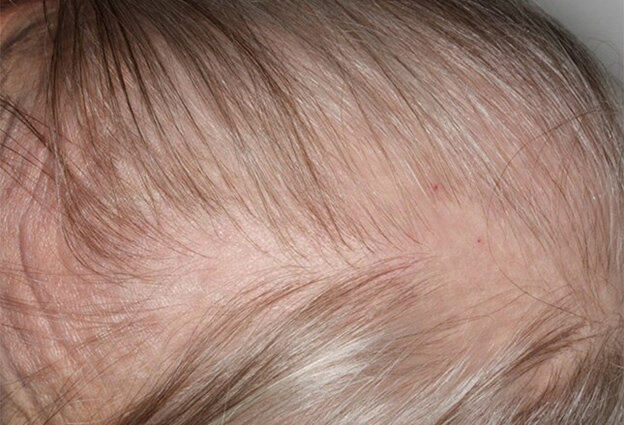Did you know over 50 million men and 30 million women in the US suffer from hair loss?
Hair loss is a problem many deal with but few openly discuss due to the emotional toll it can take on individuals. Thanks to genetics, hormones, and aging, we see hair loss patients daily. At Retief Skin Center, our providers approach each hair loss case optimistically. Just in case you’re one of the many patients that worries about losing hair, we decided to dive into the causes, possible prevention, and treatment options to help you understand hair loss a little more.
Causes of hair loss
Hair loss can happen for many reasons. The most common cause of hair loss is hereditary, called androgenic alopecia. Associated with a mix of hormonal changes and genetics, androgenic alopecia is a hair disorder that tends worsens with age, but can appear as early as puberty. Androgenic alopecia tends to affect the frontal scalp and vertex (top of scalp), and varies patient to patient. This pattern of hair loss is usually present in other family members.
Stress, including emotional (such as after a divorce or death of a loved one) and physical (including weight loss or surgery) can lead to a diffuse hair thinning all over the scalp, a type of hair loss called telogen effluvium. Many new moms experience this condition a few months after childbirth. Some patients notice telogen effluvium after losing significant amounts of weight. Telogen effluvium typically resolves after the stressful event has passed, but can take a few months.
Damaging hair care, such as chemical relaxers, and tight hair styles that pull on the scalp can also cause potentially scarring hair loss. Hair regrowth can be difficult in these cases if scarring has occurred. Certain medications or supplements have been linked to hair thinning, including antibiotics, antidepressants, oral contraceptives, and drugs that suppress the immune system. Other medical conditions, such as hypothyroidism, lupus and nutritional deficiencies, are also associated with hair loss. Bloodwork may be required to determine if these underlying medical conditions exist.
Evaluation for hair loss
When we first evaluate a patient for hair loss, we try our best to get a full picture of each patient’s history, including family hair patterns, how long symptoms have been present, past surgeries, medications, and life stress. We then examine the scalp to determine the pattern of hair loss. Do we see round patches of hair loss (as in alopecia areata), thinning in the vertex of the scalp (as with androgenic alopecia), or thinning through out the scalp (as seen in telogen effluvium)? Occasionally, a hair pull or pluck test may be performed to evaluate the hair follicle. If needed, a scalp biopsy may be performed to provide additional information, such as if scarring to the scalp has occurred or if a fungal condition is present.
Treatment options
While not all cases of hair loss will see improvement, we are exceedingly optimistic with treatment options that exist for hair loss. Most patients are aware of over the counter Rogaine, or minoxidil. Minoxidil is believed to work by lengthening the growth phase and shortening the resting phase of the hair follicles. Clinical studies show that when applied as directed, groups using minoxidil topically did see improvement in hair growth compared to placebo.
Medications that inhibit androgen production target the hormonal component of hair loss. Spironolactone is a medication commonly used for high blood pressure, but because of its hormonal effects at lower dosages is also used in women for acne, PCOS, and androgenic alopecia. Finasteride is a medication that works similarly in men.
Targeting potential inflammation of the scalp help treat and prevent hair loss in specific cases. Seborrheic dermatitis and dandruff can benefit from antifungal medications, such as Nizoral shampoo, while other conditions including psoriasis and eczema may see improvement with topical steroids or steroid injections.
Nutritional supplements play a role in the hair loss treatment. Correcting any nutritional deficiencies, as discussed previously, is clinically important. The importance of a well balanced diet low in inflammatory, processed foods and high in healthy fat and protein cannot be overstated. Zinc, iron, and vitamin A and C are also important. Supplements such as Nutrafol contain herbs that have clinically shown to help improve hair loss, including saw palmetto, curcumin, and maca.
Novel treatments have been shown to improve hair growth. PRP (platelet rich plasma) involves a quick venipuncture to obtain your own blood, which is then spun down to obtain the platelet rich plasma component (think nutrient dense) and injected into the scalp to promote hair growth. Some patients may benefit from a specific laser treatment, called low-level laser light therapy (LLLT), also referred to as "photobiomodulation therapy." This produces gentle deep heat, which is thought to increase activity of stem cells of the hair follicles
Each hair loss patient is unique, and requires a tailored approach to both diagnosis and treatment. While this condition can be frustrating, we are hopeful that with a combination of both the old and new treatment options, hair loss patients see positive improvement. If you'd like to discuss your hair loss and treatment options further, contact our office to schedule an appointment. We'd love to help.
Resources:
Atanaskova Mesinkovska N, Bergfeld WF. Hair: what is new in diagnosis and management? Female pattern hair loss update: diagnosis and treatment. Dermatol Clin 2013; 31:119.
Adil A, Godwin M. The effectiveness of treatments for androgenetic alopecia: A systematic review and meta-analysis. J Am Acad Dermatol 2017; 77:136.
Sinclair R, Wewerinke M, Jolley D. Treatment of female pattern hair loss with oral antiandrogens. Br J Dermatol 2005; 152:466.
Rathnayake D, Sinclair R. Innovative use of spironolactone as an antiandrogen in the treatment of female pattern hair loss. Dermatol Clin 2010; 28:611.
Leyden J, Dunlap F, Miller B, et al. Finasteride in the treatment of men with frontal male pattern hair loss. J Am Acad Dermatol 1999; 40:930.
Blumeyer A, Tosti A, Messenger A, et al. Evidence-based (S3) guideline for the treatment of androgenetic alopecia in women and in men. J Dtsch Dermatol Ges 2011; 9 Suppl 6:S1.
Giordano S, Romeo M, Lankinen P. Platelet-rich plasma for androgenetic alopecia: Does it work? Evidence from meta analysis. J Cosmet Dermatol 2017; 16:374.
Leavitt M, Charles G, Heyman E, Michaels D. HairMax LaserComb laser phototherapy device in the treatment of male androgenetic alopecia: A randomized, double-blind, sham device-controlled, multicentre trial. Clin Drug Investig 2009; 29:283.





